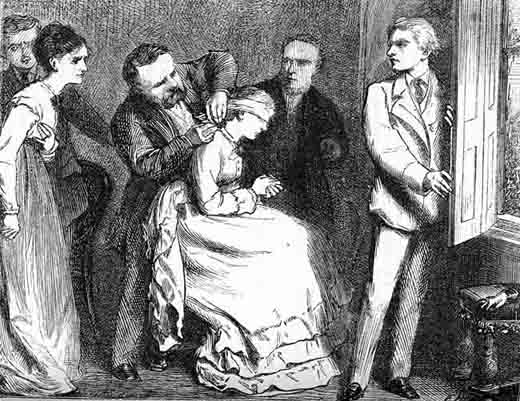Dear Serial Readers,
Finis! I savored this concluding double number and will miss this wide cast of characters! The additional length of the last issue offers a textual fanfare of a finale. Apparently there were even more words in Dickens's initial ending, but he had to strike the last two paragraphs due to space restrictions. Those lines (reprinted in the Oxford edition), about the "voices in the waves," reiterate the watery, timeless or eternal present "voices" at the end of chap 16 when Paul dies. And they also echo the very opening lines of this number, a nice cyclical shape tied to the passage of "Time" within the story and even the passage of a year and more in the delivery and reading of the story.
And the novel concludes with a different repetition, the second generation of "Paul" and "Florence," with the past now improved in the present, the affective childhoods of this Paul and Florence much more promising given the rehabilitated Dombey.
The latency of the attention to the "Daughter after all" (as Miss Tox puts it in chap 16) continues in these last paragraphs about Dombey's secret "affection" for his granddaughter Florence: he "hoards her in his heart" and no one knows. While Dombey seems redeemed as a kindly grandfather at the end, Alice and Edith do not enjoy earthly redemption, although we do learn why they resemble each other. Both are evidently moribund in one way or another--the fallen women who perish for their transgressions.
I did appreciate Edith's resistant stance towards repenting--or rather her insistence on what amounts to a contingent repentance. It's in that section of chap 51 where Edith refers to Dombey's "own present" in relation to her "past." I found this notion of one's own present intriguing, a way to recognize the variety of presentnesses within and through the reading of the novel. Dickens continues to wield the present tense strategically in this final number, most notably perhaps when Florence returns to her wrecked father in the "ruin" of the house.
The "Retribution" chapter about the dismantling of the Dombey household--all in the present tense--makes evident that the "house" of Dombey has at least three different meanings: the business, the household--both staff and the material objects that are sold, and the family itself. It seems that only in the last sense does "Dombey and Son" survive and prosper, and only through the angelic and reproductive "Daughter after all."
Stay tuned for our next serial show, THE MYSTERY OF EDWIN DROOD!
Serially signing off from Dombey and Son,
Susan

2 comments:
I've fallen behind, as you can see, but I did want to comment on Dickens's extraordinary ending to Dombey and Son before moving on to Edwin Drood.
The emphasis on the "whole year" (through repetition) in the opening paragraph did bring to mind the extended publication in parts, and the content of the installment resonated so closely with the opening chapters of the novel that I felt transported back in time.
Like the early chapters, we have what seems like an irreparable development--the fall of the "great House"--but this is not the end of the story (just as Paul's death was not the end ealier). We also have a reappearance of the animated house: "The great house...stood frowning like a dark mute on the street" (708), the return to the perennial question, "What is money?" (p. 719), and Florence singing her "old tune" (720). The
"last bottle of the old Madeira" (p. 729) also makes its appearance to remind us once again of the novel's beginning.
This gesturing back becomes explicit in the last paragraphs, where we see a new Paul,a new Florence, and a new chance to redo the past. In the end, then, we have a kind of palimpsest: a new history written over the old. For me this was an unexpectedly optimistic ending for such a dark, dark novel. I loved it!
I loved this ending, too, though I came to it so belatedly. One of the most intriguing points, to me, is that although Dickens seems to tie up every loose end obsessively (even to the wedding of Mrs. Mac Stinger), he leaves it to the reader to put two and two together and remember the portrait in Carker's room that looked so much like Edith. In the last installment, we are led to realize that it must have been the portrait of Alice, who Carker ruined and who is Edith's cousin. The subtlety of this I found remarkable in a novel that is not overly subtle.
To look back at part 18, I too was amazed, astounded, horrified, and yet entranced by the flight and death of Carker. Like Susan, I felt the resemblance to the mutual and obsessive pursuit in Frankenstein, and I had to read the chapter ending twice to assure myself that I was reading what I was reading. Here is the outcome of the monstrous railroad that overtakes the little corner where the Toodleses live, but from which the passenger can't help but see the disparities of life among the rich and poor.
All in all, a brilliant novel, and a great experience to live with it (and to share it with all of you) over a number of months. I won't be joining the group for Edwin Drood, but I'm glad I'm still on the list, as I may be more open to future possibilities. Thank you, Susan, for setting this in motion.
Post a Comment